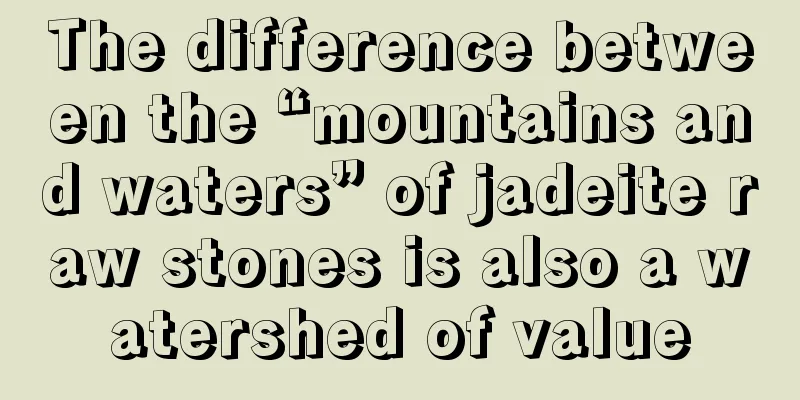The difference between the “mountains and waters” of jadeite raw stones is also a watershed of value

|
People's general understanding of jadeite raw stones is still stuck on the difference between new mines, old mines, or field sites. In fact, jadeite raw stones are also divided into "landscape" and "water". Today I will talk to you about the characteristics and differences of mountain stones, water stones, and semi-mountain and water stones in jadeite raw stones. Characteristics: Rocks are rough jadeite formed by weathering and accumulation or accumulation into clumps. They generally have a thick weathered outer skin and clear edges and corners. Rocks are mainly produced on hillsides, buried in gravel layers, and are generally mined directly from mines. Most rocks have fog (fog is a mist-like substance distributed between the skin and flesh of jadeite raw stone), but the jade quality is generally poor. The rocks are rarely washed by water, so their skin is kept intact, making it difficult to tell whether they are good or bad. However, it can still be judged by the sand hair characteristics and various manifestations on the skin. (Sand evolved from the jadeite mineral in jade, and has become an important basis for judging the quality of jade) The better the skin is, the finer, more uniform and more compact the sand is. Whether the distribution is uniform, the color of the skin, the presence of pine flowers and python belts on the skin, etc. These characteristics can also be used as a basis for judging the quality of rock jade. Characteristics: Water stone is jade rough material deposited in riverbed. It has a thin outer shell and is oval or spherical in shape. It has good roundness and no edges or corners. Most of it is brown. Water stone refers to the jadeite raw stone dug out from the river. After experiencing weathering and erosion and long-term and long-distance transportation on the riverbed, it has a better roundness. The skin of water stone is usually called water skin. Because its surface is smooth and not rough, some people also call it smooth skin. During the long process of being transported in water, the weak parts of the water stone will be gradually worn away, leaving only the firm and solid part. Coupled with long-term immersion in water, its texture will usually be more delicate, the structure denser, the color better, and the probability of producing high-quality jade will be greater. The outer skin of jade water stone is smooth without any sandiness, and there are traces of water on the surface, so you can observe the grains and small holes under a magnifying glass. The skin of water stone is thin and transparent, making it easier to see the internal color and other conditions. Water stone has another notable feature: the finished products made of water stone are much more shiny after polishing than materials from other mines. Therefore, water stone is more popular in the market, and there is a saying among the people that "water stone is good". Characteristics: As the name suggests, it is between mountain rock and water rock, with a layer of sand on the surface, which is thin and clean, but not as smooth as water rock, nor as rough as mountain rock. It can be said to be a combination of coarse and fine. The production environment of Banshan Water Stone is similar to that of Water Stone. It also requires "water" and its appearance is similar to that of Water Stone. The difference is that water stones have no sand, while semi-mountain water stones have sand but no mud. This is also a characteristic that distinguishes them from mountain stones. This is because the impurities in the rocks have been washed away by the water flow, leaving only the sand on the surface, which is hard and difficult to corrode. Generally speaking, the quality of Banshan Water Stone is not very bad, and the so-called "water-turned sand" is a typical example. After introducing the basic characteristics of these three types of jadeite raw stones, I believe everyone will have a deeper understanding of the raw stones. As I said, you should understand what you should understand, and think twice before taking action.
fcgc33 fcpf18 |
<<: Where is the future of jadeite rough stone industry?
>>: The commercial value behind the "ordinary" jadeite stone
Recommend
How to determine the grade of jadeite and how to choose jadeite
Ten years ago, the jade market was still thriving...
Why is this tiny jade egg-shaped object so expensive?
Among the many finished products of jade, egg-sha...
There are several types of glutinous jadeite, what are their characteristics, these details you need to know
What type of jade is the glutinous jade and what ...
Do you know the meaning of wearing a jade bracelet?
In the kingdom of jewelry, many women have a spec...
Many people think that jade is very cold? In fact, jade can also be very affordable and versatile
Jadeite is the king of jades. Its icy green color...
Have you learned the common methods of identifying jadeite?
Jade is known as the king of jade. Chinese people...
Taking jade as an example, let’s talk about the investment of gemstones
With the development of economy and the great imp...
The finest jade egg-shaped face is actually fake? Don’t be fooled by chalcedony again!
It is said that all beauties are similar, and in ...
Will the color of jade deceive your eyes?
Many people may know that the color and texture o...
How many red series of jadeite do you know?
The red series of jadeite includes dark red, deep...
Jade Appreciation | Stunning jade carvings that capture your heart~
Guanyin Rough Stone ▼ design ▼ Rough Carving ▼ Ca...
Jade is divided into sitting Buddha and standing Buddha, and the choice is very particular!
Carving jade into the image of jade Buddha is a c...
Jade Appreciation | Descendants of the dragon deserve the dragon’s blessing!
The dragon is the totem of the Chinese nation and...
Young man, what kind of jade looks good on you?
Jade has always been labeled with many labels: no...
Jade is divided into five grades, only the first three are worth collecting
Gold has a price but jade is priceless. Buying ja...









